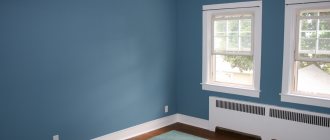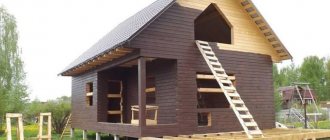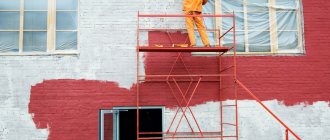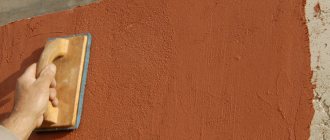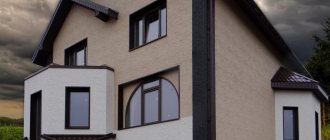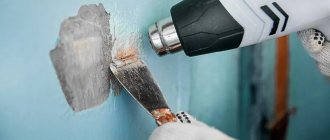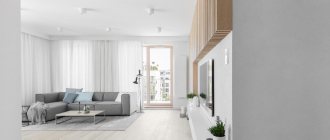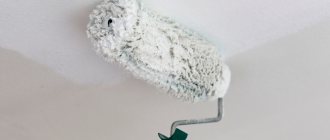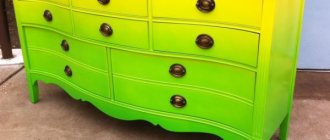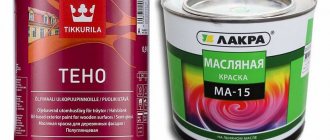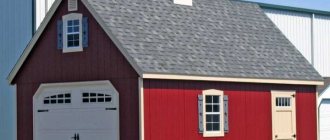mycreations October 8, 2014 Walls and façade No Comments
In construction, any finishing or finishing process for a particular material must be carried out according to a pre-prescribed technology.
Painting a house with facade paint is a technological process, some points of which must be strictly observed:
- firstly, before painting it is mandatory to prepare the surface;
- during installation work, only new and high-quality tools and materials should be used;
- before starting work, you should plan your actions in advance, dividing them into stages;
- you should choose the desired painting method, since different surfaces and different types of paints have their own optimal approaches;
- it is necessary to strictly follow the instructions for the applied coating and other materials;
- You should not skimp on paint, giving preference to little-known manufacturers - only branded products will last long enough to recoup their cost.
Earlier we talked about painting the facade of a wooden house and what compositions are best to use for this. In this article we will discuss in more detail the painting of concrete and porous surfaces.
Removing old coating
Before you start preparing the wall for painting, you need to get rid of the old finish, and this is not easy. Our tips will help you do this quickly and without unnecessary labor.
Wallpaper
At first glance, removing wallpaper is not difficult, but sometimes you have to work hard to get rid of all the remnants of the coating. The base must be cleaned completely, and only then can you proceed to the next stage.
Paper sheets are quite easy to remove. Pry them from below with a spatula and they will easily come away from the surface. If the material has firmly grown into the base, arm yourself with a spray bottle. Fill it with warm water and treat the old finish. Do not skimp on water - the more the wallpaper is soaked, the better. When the paper gets wet, it can be easily removed with a trowel.
Modern options are non-woven, vinyl ones cannot be removed so easily. Such wallpaper, especially the latter, is almost impossible to get wet through. Therefore, all that remains is to literally “punch” the way for the water using a toothed roller or knife. Moisture will penetrate through the damaged surface and soak the dried glue. If the toothed roller fails, a steamer will come to the rescue, of course, if you have one at hand.
If your household does not have such units, you will have to prepare yourself for the long and painstaking process of scraping off wallpaper and glue. If you need to clean the wall down to the concrete or brick base, you have every right to skip this unpleasant process and remove the wallpaper along with the old plaster.
Whitewash
Cleaning walls from whitewash is an incredibly difficult and tedious task. It is necessary to get rid of even the reminder that this material was present on the walls. Remains of lime or chalk will not allow the new finishing layer to be applied evenly and efficiently. A lot of pellets will form on the walls that will need to be cleaned off.
The following will help completely remove whitewash residues:
- warm water - spray the wall with a spray bottle and remove the composition with a spatula. Water is quickly absorbed, so you need to repeat wetting from time to time. Compositions that do not contain special hardeners and other additives can simply be washed off with plenty of water;
- tools that can be used to scrape off whitewash - a grinder, sandpaper, an iron brush and a spatula. During grinding, a large amount of construction dust is generated in the room. From time to time you should take breaks and leave the room until the suspension settles;
- a folk remedy consisting of soda, crushed laundry soap and water. A thoroughly mixed solution is applied to the surface, after which the finishing layer is removed using a spatula or sponge.
The main requirement is thorough cleaning of the base. If you do not pay due attention to this stage, you will have to say goodbye to the dream of beautiful walls.
Plasters and ceramic tiles
Old plaster can sometimes be left behind. If there are small defects, it is more profitable to simply repair them and thereby save a lot of money. Sometimes the putty comes off and voids form between it and the plaster. Then you can remove only this thin layer, after moistening it with water. If, after a thorough study of the formation, you find places of shedding, this is a sure sign of the presence of voids. It is better to get rid of a weak foundation. Often the problem is removing stubborn areas, but don't let that fool you. It is impossible to guarantee their reliability subsequently.
The tiles must be removed along with the tile adhesive. Cleaning the walls from ceramic cladding is done using a hammer drill equipped with a chisel-shaped attachment. First, the tile is knocked down, then the fixing material is removed. If there are defects in the exposed layer of plaster, you need to clean it down to the concrete base. There is no need to give up durable coating.
Old paint
The paint is removed using special solvents. The composition must be applied to the wall, then scraped off with a spatula. It is not recommended to cover old paint with new one, since it is impossible to guarantee a perfect result.
A hair dryer will be an excellent helper. When the painted area is heated with hot air, the paint swells with bubbles and is easily removed.
Main stages of painting
It may seem only at first glance that painting the facade of a building is a simple and simple process, and therefore accessible to everyone. However, this is how it is, but you still can’t do it without the help of specialists. And although anyone can paint a facade, only a professional can do it easily and efficiently, ultimately saving the home owner money.
Modern house painting as a process consists of several stages. Let's take a closer look at each of them.
Preparatory stage
The first stage can be called preparatory; it is carried out before painting the facade of the house. It itself is divided into two stages. First of all, it is necessary to evaluate the external walls. It consists in determining the type of material from which the walls of the building are constructed. As you know, modern housing is built in most cases from brick, but other building materials are also used, for example, slag concrete, concrete, gas blocks and other wall materials, which then need to be insulated.
Recently, wooden log houses have become fashionable again. The latter, as a rule, are varnished and use their own separate technology. Read how to paint the facade of a wooden house on our website in a separate article (follow the link).
All the others are often plastered, so the same methods are used to paint them.
But despite the material from which the building is constructed, the main stages for all types of houses are the same and in many ways similar, differing only in the nuances caused by the specifics of a particular material.
The next step can be considered the selection of materials with which the facade will be painted.
It is at this stage that it is worth using the services of experts who can give practical advice, which in the future will protect owners from the need for alterations, and therefore unnecessary financial costs.
Then you need to prepare the walls themselves for painting. Clean them from dirt, dust, old paint, if the house has already been painted. If necessary, wipe out cracks or cover up holes, if any.
For what? Then, painting a house with façade paint is done in several rather thin layers. And if you don’t prepare the surface in advance and make it perfectly flat, then after painting the facade of the house, it will be impossible to look at what happened without regret. The walls of the house will be painted, but there will not be a “new” look due to defects, depressions, dents and pits.
Padding
The second stage will be priming the walls. It also consists of two stages. Using special impregnations, the walls should be degreased. In order for the paint to adhere well to the surface of the facade, it is worth applying a special primer to it.
For old walls, it is best to use modern deep-penetrating primers that come as part of painting systems.
Painting
Having completed all these preparatory work, you can actually start painting. Painting the facade walls is carried out with various tools.
The most accessible way is to apply paint with brushes, which does not require any special skills.
Painting walls using a roller or spray gun will require some skill.
In any case, you can’t do without brushes. They will have to be used for painting in hard-to-reach places.
Types of facade paints
Silicate
This type of paint has been used for a very long time; it is especially good to use this paint when painting facades made of materials containing lime.
Well suited for painting concrete and brick surfaces.
The binding element in these paints is liquid glass.
Features of silicate paints:
- durability of the coating;
- resistance to pollution;
- resistance to aggressive harmful substances.
Latex
Latex paint is water-based and is used for painting facades and interior work. Latex paint has high adhesion to painted surfaces.
Features of latex paints:
- excellent hiding power;
- resistance to all kinds of pollution;
- resistance to any weather conditions;
- resistance to fungi and mold;
- resistance to abrasion and washing;
- almost odorless.
Acrylic
Another very commonly used water-dispersion paint for facades is acrylic paint.
Acrylic paints have many advantages. Made on the basis of acrylic polymer emulsion, they, like latex ones, have a number of remarkable properties..
Acrylic-based facade paint forms a durable film when dried.
This film adheres tightly to the surface and protects it from harmful environmental influences.
Features of acrylic paints:
- high degree of hiding power;
- ease of application;
- resistance to splashes when painting;
- reasonable price;
- Contaminants from painted surfaces can be easily removed with soapy water.
Oily
Features of acrylic paints:
- high degree of hiding power;
- ease of application;
- resistance to splashes when painting;
- reasonable price;
- Contaminants from painted surfaces can be easily removed with soapy water.
Oily
Oil paints of various colors.
Such paints, in which the binder is drying oil, are the cheapest and are often used for facade work in small dachas. Mostly these paints are used to paint wooden surfaces.
Features of oil paints:
- low price;
- form a dense film on the surface;
- takes a long time to dry;
- form short-lived coatings.
Enamels
For facade work, two types of these materials are used:
- alkyd (solutions of alkyd resins in white spirit);
- polyurethane (based on high molecular weight polyurethane resins).
Features of alkyd enamels:
- create a dense, hard film on the surface;
- The coating is quite durable.
Features of polyurethane enamels:
- create a smoother and more elastic film;
- The film is scratch and impact resistant.
Textured
Such paints are designed to produce a relief decorative coating on the surface being painted. Textured facade paints are made on the basis of various components and fillers and are used for painting concrete, brick, plastered and wooden surfaces. We will tell you more about what textured paint for facades is in the next section.
Water based paints
Water-based (water-dispersed) paints are an emulsion of small particles of a working mixture in water . When applied, water is partially absorbed into the base, and partially evaporates, leaving a coating film that, after drying, does not react at all to the influence of water.
This composition has important advantages:
- No smell . This is the main advantage of water-based materials, which often determines the choice of users.
- No strong shine . The surface has either a deeply matte or soft silky sheen. Visually matte surfaces look smoother, do not glare and create a noble and stylish appearance of a house or cottage.
- Availability of excellent working qualities of the coating . Almost all water-dispersed paints have a full set of properties that allow them to successfully perform their functions.
- Possibility of tinting in any color . All water-based compositions are available in the form of two or three types - bases. Usually the first one is white and can be used as an independent paint or tinted in some light shade. The second and third are transparent, intended for tinting into denser and brighter colors.
- Low consumption . Most water-based formulations have high hiding power and low (relatively) density, which allows them to cover a larger area than other types of paints.
- Quick drying . Unlike other types, water mixtures dry within a few hours, allowing for maximum speed of work.
- Plain water is used as a diluent, which makes the work much easier (and cheaper) and helps keep the working tools in order and clean.
The disadvantages of water-based paints are:
- Contraindications for use on metal substrates.
- Weather restrictions, cannot be applied in rainy weather.
- The stains that appear are difficult to erase, and repeated washing of the walls spoils the appearance of the coating.
The disadvantages of water-dispersed facade paints are not critical; the popularity of such compositions is steadily growing.
What paint is best to paint the facade of a house?
Painting the facade of a house with your own hands is done not only for aesthetic reasons, but also in order to protect the building from the negative influences of the environment, which can not only spoil its appearance, but also lead to destruction. Negative factors include precipitation, high humidity, sunlight, temperature changes and mechanical damage.
Painting a facade must be approached with all responsibility, since unsuccessful coating can cause hidden defects. To prevent this from happening, it is necessary to carefully prepare the base and use only high-quality materials.
What paint should be used to paint the facade of a house to make it look attractive for many years? The paint must be weather-resistant, durable, heat-resistant, have high vapor permeability and moisture-repellent characteristics, be elastic and resistant to contamination.
For exterior painting, you can use organic or inorganic paints, among which are solvent-based acrylic, alkyd and water-dispersion latex.
What paint to paint a facade made of cement? Acrylic paint is used to paint cement and plastered surfaces; it can interact with any materials. After painting, the surface is covered with a water- and light-resistant film. The coating becomes resistant to temperature changes and mechanical stress.
What paint is best for the facades of concrete houses? In this case, alkyd paint is used: it is resistant to precipitation, has good throughput and quickly sets to the surface.
To paint the base and surfaces exposed to precipitation, it is recommended to use water-dispersed latex paint containing silicone resin.
Inorganic paint consists of lime, cement or liquid glass and can be calcareous or silicate. A film does not form after it dries. Inorganic paint is used for plastered surfaces or lime bases.
Which façade paint is most optimal?
The optimally selected material must best comply with all existing conditions - operational, climatic. In addition, the decorative qualities of the coating are important, since they are primarily assessed when looking at a freshly painted house.
Recently, user preferences are increasingly given to water-dispersed compositions , which is understandable by their properties. The most important of these is the absence of odor.
The ability to remove paint stains with plain water is also important - an important plus, since solvents can also remove the necessary substances, which will lead to damage to objects accidentally stained with paint.
Nuances of facade painting
Whatever type of paint is used, the rules of painting will remain the same. The basics of such decorative cladding include:
- The building that will be painted must be at least a year old. It is not recommended to treat a newly built house, since its shrinkage continues and the humidity of the building has not yet completely stabilized.
- Before painting, the surface must be thoroughly cleaned of dirt, mold or mildew. Otherwise, the solution will lie unevenly. You will also need to pre-treat the facade with antiseptic solutions.
- The surface to be treated must be washed with soapy water and then with clean water. After this, you will need to wait about a day for the wall to dry completely.
- Since brick has a high level of hygroscopicity, it will first need to be treated with a primer mixture.
- It is best to use acrylic solutions for painting such walls.
- Before starting painting, all surfaces of the house that will not be treated must be covered with cloth or polyethylene. Otherwise, the mixture may accidentally get on the door or window, and it will be quite difficult to remove it.
- For painting, you will need to prepare a scaffolding or scaffolding, since using a ladder or stool is inconvenient and quite dangerous.
- The paint should be applied to the entire surface in one go. If an employee is tired, he can take a short break of a few hours, but no more. If painting continues the next day, the shade of yesterday's and new coatings will be very different.
- A brush, roller or spray gun can be used for painting. When working with your own hands, it is best to use a roller. It applies the composition quickly, evenly and with little consumption.
- The cladding should be done in 2 layers. A new layer is applied only after the previous one has completely dried. Drying time may vary depending on the type of dye.
- When painting with a brush or roller, you need to apply the solution with careful, even movements in different directions. This way the mixture will lie more evenly.
Painting technology
After the type of paint has been chosen and the question of how to paint the facade of a plastered house is not worth it, you need to prepare the walls for painting:
- Assess the condition of the walls: the plaster should not crumble; when you run your hand over it, there should be no dust left on your palms. If the plaster is not strong, you should putty the walls.
- Priming – it is necessary to cover the entire surface of the walls with a penetrating primer.
When moving on to painting, you need to choose a tool - a wide brush or a roller with medium-length bristles will do. But, the best option would be a spray gun.
Painting the facade with a brush
Professional technology for painting facades on plaster is performed as follows:
- Before starting work, the paint is mixed well.
- The paint, regardless of the chosen tool, is applied randomly, constantly changing direction - horizontally, vertically and diagonally. This approach will ensure maximum paint uniformity when looking at the facade from the side.
- The first layer is applied, when it is completely dry, subsequent layers are applied. Each layer must dry before applying the next.
Note! Paint on lime plaster is applied in at least 3 layers, on other types of plaster – in 2.
When painting, it is important not to pause, otherwise the boundaries of the dried painted areas will stand out from the facade.
Choosing paint for exterior work depending on the type of walls
In order for the decorative layer to serve as long as possible without the need for restoration, when choosing a paint composition, it is important to take into account the specifics of the base. Wood, foam blocks, brick and concrete have different requirements for the finishing coating
For wood
It is quite difficult to find good facade paint for wood, since plank walls are capable of rapid fire, quickly absorb liquids and are susceptible to rotting. In such conditions, the optimal solution will be substances that are not afraid of constant exposure to moisture, exhibit high-quality adhesion and excellent ductility.
When choosing paint for a wooden facade, first of all, they turn to acrylic products, since they are characterized by full adhesion to wood, help maintain natural air exchange, are quickly applied and have an impressive service life.
For a wooden house, transparent and tinted compounds are used; in the first case, the beautiful structure of the natural material is emphasized; such products have greater vapor permeability.
For foam block
Foam block surfaces are characterized by high porosity; they require full protection from moisture and contamination. The paint must exhibit serious water-repellent and vapor-permeable properties, so experts here recommend rubber and silicone compounds
When painting, special attention must be paid to the integrity of the seams so as not to form cold bridges and not cause rapid destruction or peeling of the finish.
For brick
Brick, accumulating salts, periodically releases them in the form of stains; this effect is especially noticeable after the rainy season. On such a surface, peeling and mossy areas quickly form. Therefore, builders prefer to paint brick walls only after several years of operation of the building.
The following requirements apply to coloring compositions:
- neutrality in contact with chemicals;
- mechanical strength;
- ability to release steam;
- resistance to atmospheric agents.
To decorate brick facades, substances that exhibit excellent elasticity are used: temperature fluctuations can cause expansion or contraction of the base, under such conditions the finishing is at risk of deformation and cracking.
An example of applying façade paint for brick
For ordinary solid bricks, acrylic paints can be an excellent compromise - they do not interfere with air exchange, eliminate the formation of efflorescence, and are not afraid of moisture. Walls made of silicate material need to be finished only with cement or silicate products. Ceramic brick is not demanding; it can be combined with any type of coating.
Water-based rulers can also be used for finishing bricks, but they are not appropriate in all cases, since high susceptibility to moisture is a disadvantage in conditions of frequent precipitation.
For concrete
Concrete is painted not only to improve its decorative properties, it is important to strengthen its operational capabilities and protect it from climatic conditions. Despite its initial strength, concrete quickly deteriorates in conditions of high humidity.
Concrete compositions must meet the following requirements:
- moisture repellency;
- long color retention;
- frost resistance;
- environmental friendliness;
- ease of application.
This base is compatible with almost any composition, but it should be borne in mind that each type of paint and varnish material has disadvantages when used in this way. For example:
- oil paints do not exhibit sufficient vapor permeability; they require preliminary preparation of the walls;
- water-based solutions do a poor job of preventing moisture absorption.
Silicone, acrylic, and rubber series are more appropriate here.
Choosing paint for the facade
Initially, what you should focus on when choosing paint for external walls is its performance properties, indicated by the manufacturer on the label. Or more precisely, the presence of protection from humidity, temperature changes, insects and other pests, and shelf life. In practice they use:
- acrylic;
- silicone;
- silicate paints;
- cement;
- limestone;
- oil
The first category is considered a budget and universal facing material. The base is polyacrylates and resins, forming a reliable and stable structure that protects against precipitation, UV rays and fungus. The high level of adhesion makes it possible to apply to any surface at a minimum temperature of -15 degrees. On average, consumption per 1 square meter is about 150 ml. The second type is characterized by high thermal and waterproofing qualities, polishes and penetrates into all the cracks of the surface, protecting it from atmospheric agents and exposure to the sun. The basis of silicone paint is liquid glass, it allows oxygen to pass through and prevents the formation of condensation. Consumption per 1 m2 – 150 ml. The third type is silicate paints. Resistant material with high adhesion, difficult to remove. If in the future you want to paint the facade a different color, it is better to choose a different type of color emulsion. Although its consumption is insignificant, 100-110 ml per square. Cement mixtures have high moisture resistance. The structure is viscous and requires dilution. If you follow all the manufacturer's recommendations, it is easy to apply, but the consumption is high - 200 ml per 1 square meter. Lime paints come in the form of paste and solution, they are not economical - 180 ml per m2. But they contain antifungal components that prevent the formation of mold. Oil paints are popular. They have a rich range of colors and low consumption, about 120 ml per square. The saturation of the shade depends on the number of layers applied. It is based on mineral flour and drying oil. There is no need to dilute before application. Before choosing what to paint the facade with, you need to consider the following:
- Degree of steam permeability.
- Degree of adhesion.
- Resistance to atmospheric agents.
- Drying time.
- Consumption.
- Application conditions.
- Type (matte or glossy). The first one hides minor surface irregularities. Gloss, on the contrary, emphasizes defects, shines in the sun, but is resistant to dirt.
Please note: Magnetic paint
The paint begins to exhibit its basic properties approximately a few days after application. The leading place is occupied by silicone pigment mixtures.
Acrylic facade paint
Silicate facade paint
Lime facade paint
How to paint the facade of a house using a roller and a spray gun
Painting of the facade is carried out after completion of construction and installation work. The lime-cement mortar must harden, and this takes time, on average about 1-2 months. Painting is carried out on a dry basis, subject to stable weather and at an air temperature not lower than +10 ᵒС. It is not recommended to paint in strong winds, during rain, or in bright sunlight.
To ensure that the paint applies evenly, rollers, spray guns, and sometimes brushes are used.
To prime the façade, it is recommended to use acrylic primer rather than drying oil. This composition is especially good when painting walls with a high absorbency rate. Without pre-treatment with an acrylic primer, the surface will absorb all the moisture from the paint, which will begin to crumble. In order to check the absorbency of the surface, it is doused with water. If moisture is quickly absorbed, then the surface must be thoroughly primed.
Painting with a roller. The paint is applied with a roller in different directions - vertically, horizontally, obliquely. To achieve maximum uniformity of layers, it is allowed for layers of paint to overlap one another.
Look at the photo on how to paint the facade of a house with your own hands using a roller:
Painting with a spray gun. Before using the spray gun, you must check the thickness of the paint. This is usually stated in the instructions for the color scheme. The gun cannot be used with formulations that are too thick.
Facade paints are applied in two layers, and lime paints in three. You must wait for each layer of paint to dry completely. Typically, the paint packaging indicates how long it will take to dry - on average, this time is 2-3 hours.
Here you can watch the video “Painting a facade with your own hands using a spray gun”:
Metal elements found on the facade are pre-painted with oil paint, and then with façade paint.
Technology for painting the facade and walls of a house
The easiest way to paint the facade of a house is with an electric spray gun, provided that all previous stages are completely completed.
Using a spray gun greatly simplifies the process of applying coating to the facade of a house.
During the painting process, the following recommendations should be observed:
- all unpainted parts of the facade are covered with polyethylene;
- painting work is carried out in calm weather with no precipitation, as well as at the temperature specified by the manufacturer on the packaging;
- scaffolding or scaffolding is used for painting high facades;
- one wall of the house is painted without interruption to avoid the formation of joints and stains;
- Each subsequent layer of paint is applied after the previous one has completely dried.
Painting the facade with water-based paint
General provisions
Painting the facade of a multi-storey building
- As we have already said, facade decoration has not only a decorative function, but also creates a certain degree of protection from the influence of weather and climatic conditions. For this purpose, there are various types of cladding, and one of them is facade water-based paint.
- An ordinary water-based emulsion will not work here, because we are not talking about interior work, so acrylic or silicone paint for facades is most often used. They are the most versatile and have a long service life. For example, oil-based paint can last outdoors for no more than three years, while façade water-based paint can last from seven to 11 years if properly coated.
- If the wall of the building is located on the shady side, and even on the north side, then dampness and mold may form there, so it is recommended to use an antifungal primer before painting.
Some people advise sealing gaps and cracks with sealants or foam, but this is the same as covering them with paper, and the latter will even be more beautiful after painting. It is best to seal such holes with universal tile adhesive such as Ceresit CM-11, and if the gap is very large, then with a cement-sand mortar with the addition of a plasticizer or the same adhesive (it will not crack). Such a seal will not only level the surface, but will also create a good base for paint and strengthen the structure.
How to paint a facade
Before painting the façade must be washed
- Now let's find out how to paint facade walls with water-based paint with your own hands. The very first thing to do is wash the wall. Consider a brick building.
- If the wall has never been refinished, then at the seams between the bricks you will most likely find protruding mortar that needs to be knocked down with a chisel, or even better, with an old, unnecessary chisel. If the wall was previously painted, then check that there are no blisters anywhere, because along with the old paint, the new paint will also come off.
It is best to prime a brick façade with a brush rather than a roller.
- After the wall has dried, it should be coated with a deep-penetrating primer for painting and plastering facade work. Please note that you will not be able to properly prime the entire wall with a wool or foam roller due to the masonry joints, and a concrete wall also always has some flaws that do not allow the roller to process the entire surface. Therefore, when priming the facade, it is best to use a brush, and for hard-to-reach areas (seams) use a smaller brush.
- After this, do not rush to paint the wall right away - let the primer dry. This can take from one to four hours - everything will depend on the weather (air temperature and sunlight).
Painting the facade with a spray gun
- So, the primer on the wall dries, and during this time we prepare the paint, stirring it thoroughly. It is best to apply the first layer of coating using a spray gun - it will not completely paint the wall, but will create a good coating for subsequent adhesion.
- When working with a spray gun, do not bring it closer than 20 cm to the wall, otherwise unsightly stains will remain on the surface. The first layer, due to its thinness, will dry quite quickly and you will have to wait no more than an hour and a half.
Roller in a paint bath
The next step is to paint the wall with a woolen paint roller, but first you need to prepare the paint by pouring it into a special tray
Please note that the container is designed in such a way that the paint is in the deeper part of the container, and the shallower part is intended for squeezing out the roller. Therefore, after wetting the roller, roll it back and forth across the shallow part of the tray so that it does not splatter the paint.
The second coat of paint is applied with a roller
So, apply the second layer to the wall with a roller, thanks to this the color will be more saturated and even. For convenience, you can use a holder with a long handle - this way, in a one-story building you can do without a ladder or stool.
Painting seams
The last step will be painting the seams where the spray gun and roller could not reach. After drying, the facade is ready for use for a period of 3 to 5 years or even more. You can get additional information in the video clip attached to this article.
Cost of work
| Name of works | price, rub. |
| Cleaning from dirt, dust, flaking elements of old coating with a high-pressure apparatus: | |
| — Facade | 45 |
| — Metal roofing | 35 |
| Removing mold, applying antiseptic | 150 |
| Local repair of coiled areas of plaster | 200 |
| Joining and sealing cracks | 200 |
| Surface priming: | 75 |
| — Facade | 75 |
| — Metal roofing | 50 |
| Painting in two layers: | |
| Facade in 1 color | 150 |
| in 2 colors | 175 |
| in 3 colors | 200 |
| — Metal roofing | 100 |
| — Steel gratings | 200 |
| — Wooden window frames and sashes | 200 |
| Washing windows/stained glass with a coat and slime | 50 |
| Linear elements | m. linear |
| Slope repair | 150 |
| Facade decorative elements: | |
| — Restoration | 350 |
| — Dismantling | 150 |
| - Installation | 350 |
| Priming of slopes, facade decorative elements, cornices | 60 |
| Painting: | |
| — Window and door slopes | 125 |
| — Facade decorative elements | 180 |
| — Cornice | 180 |
| — Ebbs, gutters, drains | 150 |
| Sealing of junctions | 150 |
| Dismantling of ebbs, gutters, drains | 150 |
| Installation of ebbs, gutters, drains | 350 |
| Repair of interpanel seams: | |
| — Removing old sealant | 80 |
| — Opening and cleaning the interpanel seam | 70 |
| — Insulation of the interpanel seam | 60 |
| — Sealing the interpanel seam | 90 |
Features of painting brick facades
A brick facade looks, one might say, even majestic, and thanks to the porous structure of the material itself, such walls breathe well. The main thing is not to lose this property. Painting also allows you to hide the imperfections of the masonry.
During this time, the brick should have dried thoroughly, the alkali contained in the solution has evaporated, and the salt has already appeared. Painting brick with facade paint should be done in warm weather, preferably in summer.
Preparing the walls of a brick house for painting
Further, as the work progresses, an inspection of the facade itself is carried out. If mold is found, it should be removed using special means. Efflorescence, if any, is removed with water using a stiff brush. If necessary, the operation is repeated.
After this, the walls are thoroughly washed with soap and water. When they dry (in about a day), the cracks and chips found during the preliminary inspection are puttied. If necessary, the masonry joints must be restored.
After waiting the time required for the solution to dry, specified in the instructions on the package, the areas to which it was applied are treated with sandpaper.
Priming and painting brick walls
Priming of brick walls differs only in the composition of the primer itself, which must be resistant to alkali.
It is better not to rely only on the seller’s advice, but also to see for yourself by reading the instructions. This, by the way, should also be done when the brick itself is painted with facade paint, which should be intended specifically for painting brick, and not for wood or, for example, concrete. This will preserve the vapor permeability of the walls and will serve for many years.
As a rule, painting the facade of a brick house is done every five to seven years. During subsequent painting, the entire procedure described above for preparing the facade for painting should be repeated, although, as experience shows, in most cases it will be sufficient to limit yourself to just washing the walls.
Preparing the surface for painting
As mentioned earlier, painting with facade paint requires preliminary preparation of the surface. More specifically, the base for the coating must be dense, durable, and also be primed.
The strength of the wall to be painted is determined by the following method - transparent stationery tape is glued to the facade wall, after which it is torn back after a minute.
If the tape took away pieces of the base, then you will have to strengthen the wall. If the pieces have not come off, then the facade is ready for priming and painting.
Practice shows that it is almost always necessary to improve the condition of the facade, unless it is a new building. Preliminary work involves repairing the plaster, sealing cracks and treating areas with peeling or almost peeling plaster.
The surface of the facade must be undamaged, clean and well dried before applying the paint coating.
The old layer of paint and varnish material should not form dust or peel off from the surface. If these requirements are not met, then such areas are cleaned, coated with a primer, and also with a new layer of fresh coating.
If the paintwork material is damaged over a large area, it is easier to remove the old layer completely. The easiest way to do this is to use a sandblasting machine.
If there is old finishing for wooden houses, it will have to be removed
So, painting brick with facade paint is preceded by the following work:
- Cleaning up old materials.
- Plastering the facade.
- Drying the facade for 1-2 months.
- Applying a primer layer.
External walls made of sand-lime brick that are not subject to plastering can be immediately primed and coated with a painting compound. Additionally, you can apply a transparent protective composition.
Painting of facades made of facing bricks made of ceramics, as a rule, is not carried out. If the house is lined with ordinary ceramic bricks, you need to cover it in the first one or two years of operation of the building - this way you will be able to avoid the appearance of harmful efflorescence.
Painting the external walls of a wooden house
The methods used when painting the facades of wooden houses are approximately the same as when painting houses made of any other materials, but they have some differences.
Applying a protective layer to wooden walls
When painting wooden walls, several types of paints are used, opaque paints, coating and glazing antiseptics, translucent ones. Various acrylate and oil dyes are also used.
The paint, which contains an antiseptic, serves to protect the wood; it penetrates several millimeters deep into the surface of the wood. If the wood itself has a beautiful color, then it is better to use transparent paint with an antiseptic to cover it; it will highlight not only the color, but also the structure of the wood.
The translucent composition of such paint covers the color, but just like the transparent one it is able to highlight the structure of the wood.
Stages of work when painting a facade
The work is carried out in two stages - applying a primer containing an antiseptic and painting the wooden surface of the house. The primer serves to protect wooden walls from mold, excessive humidity and fungus formation. The second layer is applied acrylate or oil facade paint.
Helpful advice! It is better to apply a primer that contains an antiseptic (required!) in two or three layers, after each layer has dried.
The paint should be applied in exactly the same way, and before painting the house, you should try painting a separate board of the same type of wood to check the color.
Before starting painting work, it is necessary to mix the paint thoroughly; during the work, it should be stirred as often as possible. Painting wooden surfaces exposed to direct sunlight and during precipitation is unacceptable. The paint should be applied with longitudinal movements of the brush.
DIY facade painting
If a glossy film has formed on the wood, then it is worth painting it with a darker color of paint. Wood that was previously painted with oil paint can be coated with paint of a similar composition or acrylate dye, but before that, carefully remove the old paint to the wood using a wire brush.
The entire surface of the walls must be thoroughly washed, then carefully remove old paint, dust and resin using a stiff brush or scraper. Ideally, after all these procedures, it is better to degrease the walls with alkaline detergents and start painting only after the walls of the house have completely dried. You need to know that the quality of all the work done directly depends on the thoroughness of preparation for them.
It happens that to remove the old layer of paint you have to resort to mechanical and chemical methods. The chemical cleaning method better preserves the surface and structure of the wood, but is more labor-intensive and time-consuming than the mechanical method. This method is applicable only when it is not possible to clean the surface by other means.
The more thoroughly the old paint was removed, the smoother the new layer will lie and the more firmly it will adhere to the surface of the wooden wall.
How to choose façade paint for a specific surface?
- First of all, to correctly select the outer covering, you should take into account the base material . Most façade coatings specialize in concrete (including after wall insulation with foam plastic), brick, aerated concrete and plasters of various compositions. At the same time, water-based paints are not always suitable for wooden surfaces and are completely unsuitable for application to metal (steel) substrates, which is the main difference from paints based on organic solvents, which serve as reliable protection for such substrates.
- The second selection factor is surface quality . The presence of shine and the color of the walls directly depend on the composition of the paint used for exterior decoration. Water-based mixtures have lighter tones and a predominantly matte surface, while organic-based materials make it possible to obtain coatings with a hard shine in dense tones, and the choice of color and its tonality is much wider than that of water-based paints.
- At the same time, we must not forget about the operating conditions of the building - in areas with high levels of atmospheric pollution from various industrial or other substances, dust or the presence of large amounts of exhaust gases (industrial or close to large highways), paints with high water-repellent ability should be used , allowing you to safely endure periodic cleaning the walls. For regions with frequent rains, this choice is also relevant, since the penetration of rainwater into the wall material threatens their destruction.
Painting the facade of a wooden house
If you need to paint a wood house, the basic steps are similar to painting any other surface. The main difference is that the wood does not have to be painted any color. If you have a house made of noble wood, it will be enough if you treat it with a special antiseptic that prevents damage to the wood and varnish it. It’s up to you to decide which varnish to choose – glossy or matte.
Don't skimp on the antiseptic. However, there is no need to skimp on the primer and paint. After all, you paint once for many years, and the more carefully you paint, the better the result you will get. If you already have a layer of old paint, you must first remove it. Otherwise, the new paint will not adhere and will not apply evenly.
Facade painting
Painting facades allows you to protect walls from moisture, wind, ultraviolet radiation, insects, fungus and other factors. The choice of facade paint is carried out in accordance with the type of surface. Properly selected paintwork will ensure many years of trouble-free operation of the facade.
Original facade painting
Sanding and priming
The final stage of work is sanding the last layer with 240-grit sandpaper. A portable light source will help you control the quality of sanding. During work, a lot of dust is generated, so you should wear a respirator and special glasses. This will protect your lungs and eyes. After sanding, carefully inspect the wall and mark any defects found with pieces of masking tape. Do not use a pencil for this purpose, as it will be difficult to paint over.
Before applying paint, it is necessary to prime the surface again with a special compound. If this is not done, you may end up with poor adhesion of the paint to the wall.
